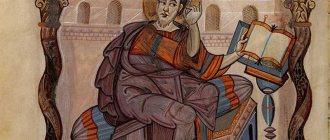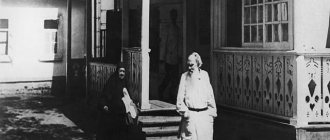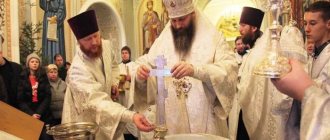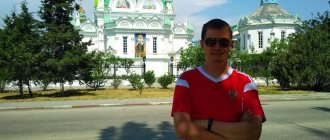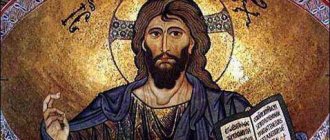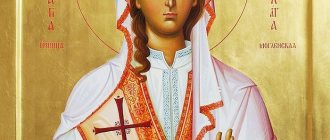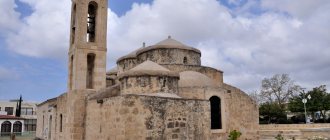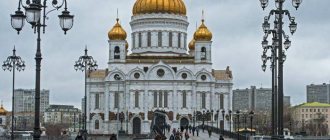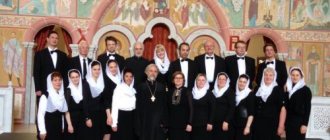Gerasim of Jordan and the Lion is one of the most interesting stories in Christianity. It not only amazes with its incredibleness, but is also very instructive.
Gerasim of Jordan is a Christian monk and saint of the 5th century. The memory of Saint Gerasimos is celebrated in the Orthodox Church on March 4, and in the Catholic Church on March 5.
Gerasim, already in his youth he decided to leave worldly life and devote himself to serving God. Having accepted monasticism, he went to Egypt, to the Thebaid desert. Then, after many years, the saint came to Palestine and settled in the Jordan Desert.
Here the Monk Gerasim established a monastery, the rules of which were distinguished by great severity. The abbot himself showed the brethren a wonderful example of perfect asceticism and abstinence. During Great Lent, the monk did not eat anything until the brightest day of the Resurrection of Christ, when he received communion of the Divine Mysteries. During the death of Saint Euthymius the Great († 473), it was revealed to the Monk Gerasim how the soul of the deceased was lifted up to heaven by Angels.
The holy ascetic met a wounded lion in the desert and healed him. In gratitude, the lion began to serve the elder as a pet until his death, after which he himself died at the grave and was buried near the saint’s tomb. The Monk Gerasim peacefully departed to the Lord in 475.
Venerable Gerasim of Lycia
The Monk Gerasim was from Lycia (Asia Minor). From his youth he was distinguished by his piety. Having accepted monasticism, the monk withdrew deep into the Thebaid desert (Egypt). Around 450 the monk came to Palestine and settled near the Jordan, where he founded a monastery.
At one time the saint was tempted by the heresy of Eutyches and Dioscorus, who recognized in Jesus Christ only the Divine nature. However, the Monk Euthymius the Great (January 20) helped him return to the right faith.
The saint established strict rules in the monastery. The monk spent five days a week in solitude, doing handicrafts and prayer. On these days, the hermits did not eat boiled food and did not even light a fire, but ate dry bread, roots and water.
On Saturday and Sunday everyone gathered at the monastery for the Divine Liturgy and received the Holy Mysteries of Christ. In the afternoon, taking with them a supply of bread, roots, water and an armful of date palm branches for weaving baskets, the hermits returned to their solitary cells.
Each one had only old clothes and matting on which to sleep. When leaving the cell, the door was not locked, so that anyone who came could enter, rest or take what they needed.
The monk himself showed a high example of asceticism. During Great Lent, he did not eat anything until the brightest day of the Resurrection of Christ, when he received Holy Communion. Going into the desert for the entire Great Lent, the monk took with him Blessed Kyriakos, his beloved disciple (September 29), who was sent to him by the Monk Euthymius the Great.
Lion Rescue
One day, during his walks in the desert, the monk met a wounded lion. In the animal’s paw there was a splinter already beginning to rot. Lev looked sadly at Gerasim, as if asking for help. The ascetic removed the splinter, washed the wound and bandaged the animal's paw. From then on, the lion, like an obedient lamb, followed on the heels of the old man.
And when the ascetic died, the lion, out of grief, stopped taking food and drink and died on his grave. Always accompanying Gerasim during his life, even after his death he found a place next to him - the elder’s followers buried the lion’s body next to the tomb.
During the death of Saint Euthymius the Great, it was revealed to the Monk Gerasim how the soul of the deceased was lifted up to heaven by Angels. Taking Kyriakos with him, the monk immediately went to the monastery of Saint Euthymius and buried his body.
The Monk Gerasim died peacefully, mourned by his brethren and disciples. Until his death, the Monk Gerasim was helped in his labors by a lion, which, after the elder’s death, died on his grave and was buried near the saint’s tomb. Therefore, the lion is depicted on icons at the feet of the saint.
What do they pray to the saint for and how does he help people?
Gerasim of Jordan is an example of perseverance, humility and meekness. Turning to the saint, those suffering ask:
- strengthen them morally and physically;
- find your purpose (set on the right path);
- teach prudence and humility;
- heal any disease, including illness that attacks domestic animals.
Constantly cultivating in himself the fortitude of the flesh, Saint Gerasim himself did not notice how he fell into the sin of Monophysitism (a teaching that denies the human nature of Christ and recognizes only His divine essence). However, the Lord enlightened the ascetic, making his life path intersect with the Monk Euthymius the Great. This pious man withdrew into the desert when the heresy of false teaching began to spread across the land of Palestine. Listening to his speeches, Gerasim received his spiritual sight and, in turn, desired solitude.
After some time, believers began to flock to him and, from his example, learn to pacify the desires of the flesh and cultivate spiritual fruits. Therefore, this saint is often resorted to when a charmer (the devil) confuses the mind and faith is shaken. Christians ask to strengthen them spiritually, to send them perseverance and protect them from the evil one.
Why to St. Gerasim receives requests for animals
The saint is considered the patron saint of animals, because he once saved the life of a lion. This incident is one of the key moments in the biography of the saint. Once in the desert, an old man met the king of beasts. The lion's paw was wounded: he could not step on it and looked pitifully at the old man
.
St. Gerasim of Jordan
The ascetic took pity on the suffering beast and, approaching him, pulled out a thorn from his swollen paw. Then he washed the wound and bandaged it carefully. Since then, the lion has become tame, as if turning into a pet. He relentlessly followed the elder, showing extraordinary meekness and intelligence.
The abbot of the monastery decided to assign his ward to the business: he assigned him to guard the water-carrying donkey. One day, when the donkey was grazing on the river bank, the lion, exhausted by the heat, took a nap on a hillock. At this time, a trade caravan passed by. The merchant coveted the stray donkey and took it with him. Waking up, the lion searched for the donkey for a long time, but in vain.
Dejectedly, he trudged into the monastery and appeared before the eyes of the elder, hanging his head in repentance. Gerasim thought that the lion had devoured the donkey and, getting angry, imposed a kind of penance on the pet. From now on, the lion had to fulfill the duties of the donkey: carry water to the monastery from the Jordan River.
This continued until one man from the military class came to the monks to repent. Seeing the unusual water carrier, the man took pity on the beast and gave the monks money to buy a new donkey. So the lion was relieved of the duties of a beast of burden.
Soon the missing item was discovered. The merchant who stole the donkey was returning from Jerusalem to Arabia along the same route - along the Jordan River. A lion wandering nearby recognized the monastery property and rushed towards the caravan with a roar. The frightened traders fled, and the lion, grabbing the bridle in his mouth, brought the donkey home. And along with the donkey came camels associated with it, loaded with wheat. Seeing this picture, the elder and other monks realized that their lion was not involved in the disappearance of the animal.
The lion spent more than five years in the monastery, now coming and then leaving. Once, returning from his next foray, the lion did not find the old man alive. Seeing the beast rushing about near the abbot’s cell, the monks took the lion to the burial place. One of the monks fell to his knees in front of the grave and burst into tears.
Then the lion began to beat his head on the floor and roar terribly. He realized where his beloved owner was. The lion refused to leave the elder’s tomb, did not eat or drink, and soon also gave up the ghost. They buried him right there so that even after death he could be close to the one to whom he was so strongly attached in life.
GERASIM OF JORDAN
Until the 12th century. images of G.I. in Byzantium. unknown in art, some researchers associate this with the mention in the “Life of St. Euthymius" by Cyril of Scythopolis about the heresy of G.I., which was temporary. Afterwards veneration of this saint prevailed as one of the pillars of Palestinian monasticism. The earliest known image of G.I. survives in the north. slope of the arch of the central apse in the Cathedral of the Nativity of the Most Holy. The Mother of God of St. Anthony of the Novgorod Monastery, 1125. The saint is depicted shoulder-length in a medallion, in his right hand there is a cross, his left hand is turned outward with his palm. Byzantine monuments. circle of this time, the image of the saint has the same features as on the Novgorod fresco. This is an old man with a wedge-shaped beard of medium length, divided into 2 strands, in monastic vestments (tunic, mantle), with his head uncovered. This is how G.I. is represented in the painting of the Enklystra altar in the monastery of St. Neophyte in Paphos (Cyprus), 1183, made by the artist. Apseudomos Theodore: frontal to full-length, in the left hand there is an unfolded scroll, the right hand is in a gesture of blessing and at the same time points to the scroll; in the painting of the altar of the cave c. mon-rya st. Theoktista near Jerusalem, con. XII century Already in these monuments, the image of G.I. is placed among the Palestinian ascetics: in the Cathedral of the Anthony Monastery - among other Palestinian saints, paired with St. Chariton the Confessor (on the opposite slope); on the Cypriot fresco - with the Monks Ephraim the Syrian, Cyriacus of Palestine, Theodore of Jordan, Pachomius the Great, Hilarion the Great and Euthymius the Great; in c. mon-rya st. Theoktista - together with St. Savva the Sanctified.
Images of the XIII-XVI centuries. basically repeat the compositional arrangement (in the row of saints) and the iconography of the saint presented in the monastery of St. Neophyte (usually a half-length image, the scroll is rolled up): southwest. corner of the Timotesubani Cathedral (Georgia), 1205-1215, - surrounded by saints and martyrs; narthex of the cathedral in Mileshevo, ca. 1228 - among the Palestinian saints (Hilarion the Great, Theoktist of Palestine, Euthymius the Great, Savva the Sanctified); in the painting of the deacon c. Vmch. George in Staro Nagorichino (Macedonia), 1317-1318, - paired with St. Chariton among other saints; in the narthex of the cathedral of the Hilandar monastery on Mount Athos, 1319; in the monastery of St. John the Baptist in Serra (Ser, Greece), between 1333 and 1345, - next to the Venerable Macarius of Alexandria, Macarius of Egypt, Siso, Ammon, John Kolov, Macarius of Rome, etc.; in the refectory c. Great Lavra of St. Athanasius on Mount Athos, 1512, full-length, with an unfolded scroll, next to St. Euthymius the Great; in c. Panagia Raviotissa in Kastoria, 1533. In the mineain cycles, G. I. is often represented alone: for example, in the fresco minologies in c. Assumption of the Virgin Mary in Gracanica (Kosovo and Metohija), ca. 1320, - shoulder-length medallion and Treskavets (Macedonia), between 1334-1343, - full-length; on a miniature from Greco-cargo. manuscripts of the 15th century. G.I. is depicted on l. 47 - frontal full-length, in a red mantle and green cassock, on the l. 48 — shoulder-length medallion, brown mantle; in c. St. Nicholas in Pelinov (Montenegro), 1717-1718, full length; in Russian Menaion icons for March (for example, 16th century, VGIAHMZ, end of the 16th century, KOKHM) and on the Menaion the annual beginning. XIX century (UKM).
St. Gerasim of Jordan. Icon. Con. XVII - beginning XVIII century (GMZK) Rev. Gerasim of Jordan. Icon. Con. XVII - beginning XVIII century (GMZK)
In the beginning. XIV century an image appeared of the hagiographic cycle of G.I., known from the story of John Moschus set forth in the Sinai Patericon. The earliest cycle of life is represented in the painting in the c. St. Nicholas Orphanos in Thessalonica (Greece), 1309-1319, - to the north. south wall parts of the narthex. The composition is read from left to right and is located in 2 registers not separated from each other (the lower part with significant losses). Among the subjects presented in the upper part: G. I. removes a splinter from the lion’s paw - the saint without a robe, in a tunic and schema, sits on a bench with a stool, in his left hand, resting on his knee, a staff is inserted (the artist endowed the lion has a touching feature - he is afraid to look at G.I.’s healing and he turned his head away from the saint); a lion leads a donkey with water-carriers by the bridle, he is met on the left by G.I. (in full monastic vestments), on the right - a young monk, with a gesture asking G.I. about a miracle; theft of a donkey - the kidnappers are represented as dark-skinned men and women in characteristic headdresses, with earrings in their ears, riding camels. In the lower register, the upper part of the figure of G.I. is preserved, apparently reproaching the lion for allegedly eating the donkey; lion attack on kidnappers. A hagiographic cycle similar in the composition of the stamps is presented in the paintings of the north-east. chapels in the rock c. With. Ivanova (Bulgaria), 3rd quarter. XIV century
Images of G. I. with a lion, usually sitting or lying at the feet of the saint, were included in the front Menaions. This is how the saint is represented in the Greco-cargo miniature. manuscript (RNB. OI 58. L. 102 vol., 15th century) - G.I. in a dark brown mantle and a light blue chiton, in a schema, holds a cross in his right hand, his left hand in front of his chest is turned outward, legs G.I. - a small figurine of a standing lion; images of G.I. with a lion are found in the post-Byzantine era. time and in the paintings: in the exonarthex of the Voronet monastery (Romania), 1547, in the wall minology in the narthex c. St. Apostles [St. Spas], Peć Patriarchate (Kosovo and Metohija), 1561, - sitting on a sarcophagus, removing a thorn from the paw of a lion (on March 5). This version of the image is also preserved in the single image of G.I. as a revered saint (for example, in the painting of the Cathedral of the Nativity of the Virgin Mary in Ferapontov Monastery, 1502, on the north wall).
In Rus', the hagiographic composition became widespread in the 16th-17th centuries, although the time of appearance of the earliest image “Gerasim removing a splinter from the lion’s paw” dates back to 1359 and is associated with the Novgorod monument - the Ludogoschensky cross. The same plot is later displayed in the middle of the icons, replacing, therefore, the individual image of the saint, for example, on the icon “St. Gerasim, also on the Erdan” (the inscription on the back of the icon: “Gerasim, on the Jordan with the lion”; I half of the 16th century, Tretyakov Gallery) - against the backdrop of white rocky hills, G. I. sits on a gilded throne with a gilded foot, removing a splinter from a lion’s paw. In the foreground, parallel to the line of the ark, is the stream of the Jordan, to the left. in the upper corner behind high stone walls with an entrance gate is the monastery of G.I. with a single-domed temple in the center and 3 chambers. To 2nd half. XVII century refers to the icon of the north. letters “Gerasim on the Jordan” with 12 hagiographic scenes” (Tretyakov Gallery) - in the middle against the background of the arch, G.I. is depicted with an unrolled scroll in his hand, at his feet - a lion. The stamps illustrate in detail the history of G.I.: 1. “Reverend Gerasim tied the lion’s leg”; 2. “...the lion leads the donkey”; 3. “The lion ate the donkey of St. Gerasim”; 4. “The men of Arabia led the donkey away from the lion”; 5. “Gerasim gave the lion bread and juice”; 6. “The lion destroys the donkey, he comes humble and looks down”; 7. “The lion recognized his donkey, bring it to the Monk Gerasim”; 8. “The lion brought the donkey and camels to Gerasim”; 9. “The Monk Izosim came to the Monk Gerasim, and the lion fell at his feet”; 10. “Reverend Gerasim bless the lion, he left Gerasim”; 11. “When the lion came to Izosim, he did not see the Monk Gerasim and wept”; 12. “Reverend Izosim showed the coffin of St. Gerasim, the lion fell on the coffin, wept and died.” On the icon XVII - beginning XVIII century (GMZK), as the name suggests in the upper field, represents “The Abode of the Venerable Gerasim, who is on the Jordan and the lion worked for him.” The icon has a horizontally elongated shape and includes several. episodes from the life of G.I., located within the same composition: in the 1st plan a saint is shown healing a lion - the image is built according to tradition. diagram (G.I.’s legs are bent at the knees, like a person sitting, but there is no bench or foot); in the background on a smaller scale there are 2 more episodes: St. Zosima shows the lion the coffin of G.I., and the lion dies on the coffin of the saint (“The lion also died over the coffin of Gerasim and buried (Zosima) the lion near the coffin of the saint”). The upper register is occupied by an image of G.I.’s monastery, which is far from Palestinian topography: white stone buildings with kokoshniks, onion-shaped gilded domes, red roofs behind a stone, red brick fence.
From the collection of N.P. Likhachev comes a collection of con. XVII century, which includes on the first 14 pages “The Tale of Saint Gerasim, who was the lion’s work,” illustrated with 12 miniatures, is the only illustrated handwritten copy of the story about G.I. known today (FIRI RAS. Collected by Likhachev No. 638). The nature of the miniatures, painted in 2-3 colors, is reminiscent of popular prints.
The popularity of G. I.’s life is evidenced by its repeated reproduction in engravings. According to the arch of D. A. Rovinsky, 4 images are known: the sheet “St. Gerasim” by Leonty Bunin (1714) with 4 scenes from the Life, with signatures in 2 stamps with the history of G.I.; engraving in 3 sheets “Reverend Gerasim with the Act”, 1st half. 18th century, - on the left is a life-size image of G.I., the rest of the part is divided into 2 stripes, in which there are 10 scenes from his life; engraving in 4 sheets “S. “Reverend Gerasim on the Jordan” by Ivan Lyubetsky, dated 1735, - G.I. is represented in the middle, on the sides there are 10 marks of the life, similar to the previous engraving, with minor changes in the text; sheet engraving “Teacher. Gerasim with his deed”, 1820-1830, - in the middle of G.I., on the sides and top there are 10 scenes from the life, below is a signature with a brief summary in 10 lines (there are options in 9 and 8 lines) of the history of G.I.
In the painting beginning. XXI century Vvedenskaya c. Gerasimov Boldinsky Monastery (above the entrance to the temple from the refectory chamber) the monk is depicted standing before Jesus Christ together with St. Gerasim Boldinsky.
In "Erminia" by Dionysius Furnoagrafiot, beginning. XVIII century, in section. “Our Reverend Hermit Fathers” G.I. is described as “an old man with a thick beard” (Part 3. § 13. No. 32). In the iconographic original, consolidated edition, 18th century. (collection of S. T. Bolshakov), the appearance of G. I. is likened to St. Blaise of Sebastia, “... the lion under his feet is Vokhryan, [G. I.] blesses with his hand, and in the left hand there is a scroll, and in the scroll he says: In the name of the Lord the beast has obedience, and Inda writes: the beast had this obedience to Adam.”
Lit.: Erminia DF. P. 171; Bolshakov. The original is iconographic. P. 77; Rovinsky. Í folk pictures. Book 3. pp. 571-574. No. 1419-1422; Antonova, Mneva. Catalog. T. 2. Cat. 518, 1047; LCI. Bd. 6. Sp. 391-393; Ξυγγόπουλος Α. ?? . Θεσσαλονίκη, 1973. Σ. 13-15. Pl. 9-11; Bakalova E. Scenes from the Life of St. Gerasimus of Jordan in Ivanovo // ZLU. 1985. T. 21. P. 105-122; Tomekovic S. Note sur saint Gerasime dans l'art byzantin // Ibid. pp. 277-285; Kühnel G. Wall Painting in the Latin Kingdom of Jerusalem. B., 1988. P. 187-191; Evseeva. Athos book. pp. 199, 201, 281; Polyakova O. A. Masterpieces of Russian. icon painting of the 16th-19th centuries. M., 1999. No. 40; Kostroma icon of the 13th-19th centuries: Cat. M., 2004. P. 480. Cat. 27; Sarabyanov V.D. Cathedral of the Nativity of Our Lady of the Antony Monastery 1125 // Lifshits L.I., Sarabyanov V.D., Tsarevskaya T.Yu. Monumental painting Vel. Novgorod: Con. XI - 1st quarter. XII century St. Petersburg, 2004. Section. 2 [Description of painting]. pp. 597-600; Lebedeva I. N. On the problem of Russian relationships. book miniatures and icon painting // Chrysograph. M., 2005. Issue. 2. P. 289.
E. V. Shevchenko
Amazing stories
The archimandrite of the monastery of St. Gerasimos of Jordan, Father Chrysostomos (Tavulareas), repeatedly witnessed the posthumous benefits of the saint.
One day the monastery was ravaged by thieves. They took with them ancient icons, vessels necessary for the celebration of the Sacrament of the Eucharist, and even the Gospel. Father Chrysostom immediately ran to the Arab police, but law enforcement officers did not find a single clue that could point to the trail of the robbers. The patriarch sinfully thought that the abbot himself had robbed the monastery and gave him a week to return the relics to their place. Father Chrysostom, confused in his mind, entered the monastery and, standing in front of the icon of St. Gerasim, exclaimed in his hearts: “For so many years I have served you with love and diligence, but you don’t want to help! Now suspicion has fallen on me that I took these things away! I won’t light your lamp and I won’t ring the bells anymore!”
Having extinguished the fire in the lamp, the abbot left. The next day, early in the morning, an excited policeman came running to him and told him that at night Gerasim of Jordan himself appeared to him with the order to go and console the grieving priest. In fact, the police did not stop searching for the thieves, but for some reason they misled the abbot.
Soon, law enforcement officers caught the criminals and returned its shrines to the monastery. Ashamed of his lack of faith, Father Chrysostom immediately lit a lamp in front of the icon of the patron saint and prayed for a long time, thanking him for his help.
Venerable Gerasim of Jordan
Brief life of St. Gerasim of Jordan
He was originally from the city of Lycia (Cappadocia, Asia Minor).
Already in his youth, he decided to leave worldly life and devote himself to serving God. Having accepted monasticism, he went to Egypt, to the Thebaid desert. Then, after many years, the saint came to Palestine and settled in the Jordan Desert. Here the Monk Gerasim established a monastery, the rules of which were distinguished by great severity. The abbot himself showed the brethren a wonderful example of perfect asceticism and abstinence. During Great Lent, the monk did not eat anything until the brightest day of the Resurrection of Christ, when he received communion of the Divine Mysteries. During the death of Saint Euthymius the Great († 473), it was revealed to the Monk Gerasim how the soul of the deceased was lifted up to heaven by Angels. The holy ascetic met a wounded lion in the desert and healed him. In gratitude, the lion began to serve the elder as a pet until his death, after which he himself died at the grave and was buried near the saint’s tomb. The Monk Gerasim peacefully departed to the Lord in 475.
Complete Life of St. Gerasim of Jordan
The Monk Gerasim was from Lycia (Asia Minor). From his youth he was distinguished by his piety. Having accepted monasticism, the monk withdrew deep into the Thebaid desert (Egypt). Around 450 the monk came to Palestine and settled near the Jordan, where he founded a monastery.
At one time the saint was tempted by the heresy of Eutyches and Dioscorus, who recognized in Jesus Christ only the Divine nature. However, the Monk Euthymius the Great (January 20) helped him return to the right faith.
The saint established strict rules in the monastery. The monk spent five days a week in solitude, doing handicrafts and prayer. On these days, the hermits did not eat boiled food and did not even light a fire, but ate dry bread, roots and water. On Saturday and Sunday everyone gathered at the monastery for the Divine Liturgy and received the Holy Mysteries of Christ. In the afternoon, taking with them a supply of bread, roots, water and an armful of date palm branches for weaving baskets, the hermits returned to their solitary cells. Each one had only old clothes and matting on which to sleep. When leaving the cell, the door was not locked, so that anyone who came could enter, rest or take what they needed.
The monk himself showed a high example of asceticism. During Great Lent, he did not eat anything until the brightest day of the Resurrection of Christ, when he received Holy Communion. Going into the desert for the entire Great Lent, the monk took with him Blessed Kyriakos, his beloved disciple (September 29), who was sent to him by the Monk Euthymius the Great.
During the death of Saint Euthymius the Great, it was revealed to the Monk Gerasim how the soul of the deceased was lifted up to heaven by Angels. Taking Kyriakos with him, the monk immediately went to the monastery of Saint Euthymius and buried his body.
The Monk Gerasim died peacefully, mourned by his brethren and disciples. Until his death, the Monk Gerasim was helped in his labors by a lion, which, after the elder’s death, died on his grave and was buried near the saint’s tomb. Therefore, the lion is depicted on icons at the feet of the saint.
See also: “ The Life of our Venerable Father Gerasim, who lived on the Jordan” as presented by St. Demetrius of Rostov.
